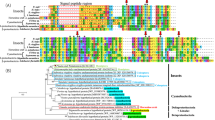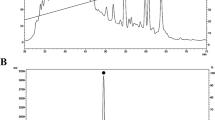Abstract
Animals and higher plants express endogenous peptide antibiotics called defensins. These small cysteine-rich peptides are active against bacteria, fungi and viruses. Here we describe plectasin—the first defensin to be isolated from a fungus, the saprophytic ascomycete Pseudoplectania nigrella. Plectasin has primary, secondary and tertiary structures that closely resemble those of defensins found in spiders, scorpions, dragonflies and mussels. Recombinant plectasin was produced at a very high, and commercially viable, yield and purity. In vitro, the recombinant peptide was especially active against Streptococcus pneumoniae, including strains resistant to conventional antibiotics. Plectasin showed extremely low toxicity in mice, and cured them of experimental peritonitis and pneumonia caused by S. pneumoniae as efficaciously as vancomycin and penicillin. These findings identify fungi as a novel source of antimicrobial defensins, and show the therapeutic potential of plectasin. They also suggest that the defensins of insects, molluscs and fungi arose from a common ancestral gene.
This is a preview of subscription content, access via your institution
Access options
Subscribe to this journal
Receive 51 print issues and online access
$199.00 per year
only $3.90 per issue
Buy this article
- Purchase on Springer Link
- Instant access to full article PDF
Prices may be subject to local taxes which are calculated during checkout



Similar content being viewed by others
References
Tossi, A., Sandri, L. & Giangaspero, A. Amphipathic, α-helical antimicrobial peptides. Biopolymers 55, 4–30 (2000)
Zasloff, M. Antimicrobial peptides of multicellular organisms. Nature 415, 389–395 (2002)
Boman, H. G. Innate immunity and the normal microflora. Immunol. Rev. 173, 5–16 (2000)
Matsuzaki, K. Why and how are peptide–lipid interactions utilized for self-defense? Magainins and tachyplesins as archetypes. Biochim. Biophys. Acta Biomembr. 1462, 1–10 (1999)
Yang, L., Weiss, T. M., Lehrer, R. I. & Huang, H. W. Crystallization of antimicrobial pores in membranes: magainin and protegrin. Biophys. J. 79, 2002–2009 (2000)
Shai, Y. Mechanism of the binding, insertion and destabilization of phospholipid bilayer membranes by α-helical antimicrobial and cell non-selective membrane-lytic peptides. Biochim. Biophys. Acta Biomembr. 1462, 55–70 (1999)
Park, C. B., Kim, H. S. & Kim, S. C. Mechanism of action of the antimicrobial peptide buforin II: buforin II kills microorganisms by penetrating the cell membrane and inhibiting cellular functions. Biochem. Biophys. Res. Commun. 244, 253–257 (1998)
Kragol, G. et al. The antibacterial peptide pyrrhocoricin inhibits the ATPase actions of DnaK and prevents chaperone-assisted protein folding. Biochemistry 40, 3016–3026 (2001)
Del Castillo, F. J., Del Castillo, I. & Moreno, F. Construction and characterization of mutations at codon 751 of the Escherichia coli gyrB gene that confer resistance to the antimicrobial peptide microcin B17 and alter the activity of DNA gyrase. J. Bacteriol. 183, 2137–2140 (2001)
Gennaro, R., Zanetti, M., Benincasa, M., Podda, E. & Miani, M. Pro-rich antimicrobial peptides from animals: structure, biological functions and mechanism of action. Curr. Pharm. Des. 8, 763–778 (2002)
Lehrer, R. I. & Ganz, T. Cathelicidins: a family of endogenous antimicrobial peptides. Curr. Opin. Hematol. 9, 18–22 (2002)
Zanetti, M. Cathelicidins, multifunctional peptides of the innate immunity. J. Leukoc. Biol. 75, 39–48 (2004)
Lehrer, R. I. Primate defensins. Nature Rev. Microbiol. 2, 727–738 (2004)
Ganz, T. Defensins: antimicrobial peptides of innate immunity. Nature Rev. Immunol. 3, 710–720 (2003)
Selsted, M. E., Szklarek, D. & Lehrer, R. I. Purification and antibacterial activity of antimicrobial peptides of rabbit granulocytes. Infect. Immun. 45, 150–154 (1984)
Selsted, M. E., Szklarek, D., Ganz, T. & Lehrer, R. I. Activity of rabbit leukocyte peptides against Candida albicans. Infect. Immun. 49, 202–206 (1985)
Lehrer, R. I., Daher, K., Ganz, T. & Selsted, M. E. Direct inactivation of viruses by MCP-1 and MCP-2, natural peptide antibiotics from rabbit leukocytes. J. Virol. 54, 467–472 (1985)
Daher, K., Selsted, M. E. & Lehrer, R. I. Direct inactivation of viruses by human granulocyte defensins. J. Virol. 60, 1068–1074 (1986)
Cole, A. M. Minidefensins and other antimicrobial peptides: candidate anti-HIV microbicides. Expert Opin. Ther. Targets 7, 329–341 (2003)
Yang, D. et al. β-defensins: linking innate and adaptive immunity through dendritic and T cell CCR6. Science 286, 525–528 (1999)
Biragyn, A. et al. Toll-like receptor 4-dependent activation of dendritic cells by β-defensin 2. Science 298, 1025–1029 (2002)
Becker, F. et al. Development of in vitro transposon assisted signal sequence trapping and its use in screening Bacillus halodurans C125 and Sulfolobus solfataricus P2 gene libraries. J. Microbiol. Methods 57, 123–133 (2004)
Schnorr, K., Hansen, M. T., Mygind, P. H., Segura, D. R. & Kristensen, H.-H. Novel plectasin polypeptide having antimicrobial activity, useful for (for example) killing or inhibiting microbial cell growth, for use as a medicament and as antimicrobial therapeutic or prophylactic agent. International patent application WO2003044049–A1 (2003).
Froy, O. & Gurevitz, M. Arthropod defensins illuminate the divergence of scorpion neurotoxins. J. Pept. Sci. 10, 714–718 (2004)
Yang, Y. S. et al. Solution structure and activity of the synthetic four-disulfide bond Mediterranean mussel defensin (MGD-1). Biochemistry 39, 14436–14447 (2000)
Landon, C., Sodano, P., Hetru, C., Hoffmann, J. & Ptak, M. Solution structure of drosomycin, the first inducible antifungal protein from insects. Protein Sci. 6, 1878–1884 (1997)
Volkoff, A. N. et al. Characterization and transcriptional profiles of three Spodoptera frugiperda genes encoding cysteine-rich peptides. A new class of defensin-like genes from lepidopteran insects? Gene 319, 43–53 (2003)
Bulet, P. et al. A novel insect defensin mediates the inducible antibacterial activity in larvae of the dragonfly Aeschna cyanea (Paleoptera, Odonata). Eur. J. Biochem. 209, 977–984 (1992)
Doolittle, R. F., Feng, D. F., Tsang, S., Cho, G. & Little, E. Determining divergence times of the major kingdoms of living organisms with a protein clock. Science 271, 470–477 (1996)
The Clinical and Laboratory Standards Institute (formerly the National Commmittee for Clinical Laboratory Standards). Guideline M7–A6: Methods for dilution antimicrobial susceptibility tests for bacteria that grow aerobically. http://www.nccls.org.
Steinberg, D. A. & Lehrer, R. I. in Methods in Molecular Biology Vol. 78 (ed. Schafer, W. M.) 169–186 (Humana, Totowa, New Jersey, 1997)
Frimodt-Møller, N., Knudsen, J. D. & Espersen, F. in Handbook of Animal Models of Infection (eds Zak, O. & Sande, M. A.) 127–136 (Academic, London, 1999)
Erlendsdottir, H. et al. Penicillin pharmacodynamics in four experimental pneumococcal infection models. Antimicrob. Agents Chemother. 45, 1078–1085 (2001)
Bayles, K. W. The bactericidal action of penicillin: New clues to an unsolved mystery. Trends Microbiol. 8, 274–278 (2000)
Williams, D. H. & Bardsley, B. The vancomycin group of antibiotics and the fight against resistant bacteria. Angew. Chem. Int. Edn Engl. 38, 1173–1193 (1999)
Nakajima, Y. et al. Antibacterial activity and mechanism of action of tick defensin against Gram-positive bacteria. Biochim. Biophys. Acta 1624, 125–130 (2003)
Hjort, C. M. in Genetically Engineered Food: Methods and Detection (ed. Heller, K. J.) 86–99 (Wiley, 2003)
Yoder, W. T. & Lehmbeck, J. in Advances in Fungal Biotechnology for Industry, Agriculture, and Medicine (eds Tkacz, J. S. & Lange, L.) 201–219 (Kluwer Academic/Plenum, New York, 2004)
The Advisory Committee on Immunization Practices. Prevention of pneumococcal disease: recommendations of the Advisory Committee on Immunization Practices (ACIP). Morb. Mortal. Wkly Rep. 46, 1–24 (1997)
Klugman, K. P. Bacteriological evidence of antibiotic failure in pneumococcal lower respiratory tract infections. Eur. Respir. J. 20 (suppl.), 3s–8s (2002)
Fleming, A. On the antibacterial action of cultures of a Penicillium, with special reference to their use in the isolation of B. influenza. Br. J. Exp. Pathol. 10, 226–236 (1929)
Chirgwin, J. M., Przybyla, A. E., MacDonald, R. J. & Rutter, W. J. Isolation of biologically active ribonucleic acid from sources enriched in ribonuclease. Biochemistry 18, 5294–5299 (1979)
Ludvigsen, S., Thim, L., Blom, A. M. & Wulff, B. S. Solution structure of the satiety factor, CART, reveals new functionality of a well-known fold. Biochemistry 40, 9082–9088 (2001)
Kjær, M., Andersen, K. V. & Poulsen, F. M. Automated and semiautomated analysis of homo- and heteronuclear multidimensional nuclear magnetic resonance spectra of proteins: the program PRONTO. Methods Enzymol. 239, 288–307 (1994)
Laskowski, R. A., Rullmann, J. A., Macarthur, M. W., Kaptein, R. & Thornton, J. M. AQUA and PROCHECK-NMR: Programs for checking the quality of protein structures solved by NMR. J. Biomol. NMR 8, 477–486 (1996)
DeLano, W. L. The PyMOL Molecular Graphics System http://www.pymol.org (DeLano Scientific, San Carlos, California, 2002)
Acknowledgements
We thank I. Ellingsgaard, A. L. Hansen, M. Markvardsen, J. Theil, A. Blom, B. Nielsen, B. Cherry, S. Otani and F. Hansen for expert technical assistance.
Author information
Authors and Affiliations
Corresponding author
Ethics declarations
Competing interests
R.L.F., S.L., N.F.-M., R.I.L. and M.Z. are consultants to Novozymes, and the other authors (P.H.M., K.M.S., M.T.H., C.P.S., D.R., S.B., B.C., L.D.M., O.T., D.Y., S.G.E.-J., M.V.S., B.E.C., S.K. and H.-H.K.) are employees of Novozymes. K.M.S., M.T.H., P.H.M., D.R. Segura and H.-H.K. have filed a patent application that covers this work (ref. 23).
Supplementary information
Supplementary Notes
This file contains Supplementary Figures S1–S5, Supplementary Tables S1 and S2 and Supplemen-tary Methods. (DOC 649 kb)
Rights and permissions
About this article
Cite this article
Mygind, P., Fischer, R., Schnorr, K. et al. Plectasin is a peptide antibiotic with therapeutic potential from a saprophytic fungus. Nature 437, 975–980 (2005). https://doi.org/10.1038/nature04051
Received:
Accepted:
Issue Date:
DOI: https://doi.org/10.1038/nature04051
This article is cited by
-
Expression and characterization of the new antimicrobial peptide AP138L-arg26 anti Staphylococcus aureus
Applied Microbiology and Biotechnology (2024)
-
In silico characterization of cysteine-stabilized αβ defensins from neglected unicellular microeukaryotes
BMC Microbiology (2023)
-
An insight into endophytic antimicrobial compounds: an updated analysis
Plant Biotechnology Reports (2023)
-
The future of recombinant host defense peptides
Microbial Cell Factories (2022)
-
pH- and concentration-dependent supramolecular assembly of a fungal defensin plectasin variant into helical non-amyloid fibrils
Nature Communications (2022)
Comments
By submitting a comment you agree to abide by our Terms and Community Guidelines. If you find something abusive or that does not comply with our terms or guidelines please flag it as inappropriate.



